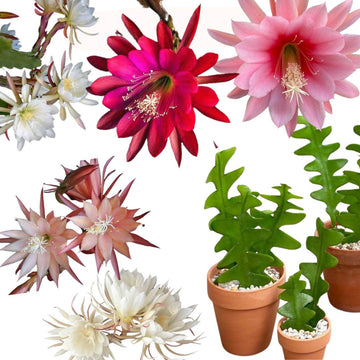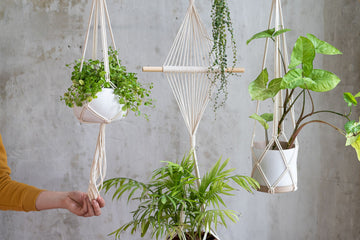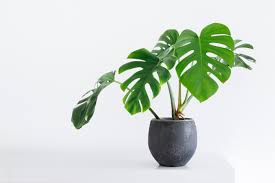
What is Brahma Kamal Plant?
As the name suggests, the Brahma Kamal plant refers to a flower that resembles Brahma's (a Hindu God) beloved flower, almost like a lotus but growing in soil. However, does it mean the Brahma Kamal plant is from India or has some reference with mythology? Unfortunately, the answer is no. The flower of the Epiphyllum plant resembles Brahma's Kamal, so people started calling it Brahma Kamal for ease of pronunciation. However, it is known by many names such as the Queen of the Night, Epiphyllum (its scientific name), or Orchid Cactus.
Let's Dive in more details
The Epiphyllum, commonly known as orchid cactus or leaf cactus, is a genus of epiphytic cacti native to Central and South America majorly from Costa Rica, Brazil, Guatemala and Mexico regions.
Unlike typical cacti, Epiphyllums grow in tropical forests, often as epiphytes on trees or rocks, hence the name "epiphyllum," which means "upon the leaf" in Greek. See in below image

These plants are characterized by flattened, leaf-like stems that are broad and often drooping. The stems are segmented, with serrated edges, and can vary in color from green to reddish-brown.

Epiphyllums produce large, showy flowers that bloom mainly at night and are pollinated by moths or bats. The flowers come in various colors, including white, pink, red, orange, and yellow, and they often have a delightful fragrance. See in below image.

They are popular as ornamental plants due to their spectacular blooms and ease of cultivation, especially in hanging baskets or pots where their trailing stems can cascade gracefully. At budsnblush we have more then 7 varieties of brahmakamal plant. At budsnblush you can buy brahmakamal plant in red, white or pink color. Red brahmakamal plant is one of budsnblush best seller brahmakaml plant. We are also providing combo offer to buy brahmakamal plant.
How To Care BrahmaKamal Plant
Light: Epiphyllums prefer bright, indirect light. Avoid direct sunlight, especially during the hottest part of the day, as it can scorch their leaves. Place them near a window where they can receive filtered sunlight or in a location with bright, indirect light.
Temperature: Keep your Epiphyllum in a warm environment, ideally between 18°C to 32°C. They can tolerate slightly cooler temperatures during the winter but should be protected from frost.
Watering: Water your Epiphyllum thoroughly when the top inch (2.5 cm) of soil feels dry to the touch during the growing season (spring and summer). Reduce watering in the fall and winter, allowing the soil to dry out more between waterings. Always ensure good drainage to prevent waterlogging, which can lead to root rot.
Humidity: Epiphyllums appreciate moderate to high humidity levels. You can increase humidity by placing a tray of water with pebbles beneath the plant or by using a humidifier, especially during dry winter months.
Soil: Plant your Epiphyllum in well-draining, slightly acidic soil. A mix of potting soil, perlite, and peat moss works well. Repot your plant every 2-3 years or when it outgrows its pot. Frequent repotting may kill the plant.
Fertilization: Feed your Epiphyllum with a balanced, water-soluble fertilizer diluted to half strength every 4-6 weeks during the growing season. Reduce or stop fertilizing in the fall and winter when growth slows down.
Pruning: Remove any dead, yellowing, or damaged stems and foliage to promote healthy growth. You can also prune to control the size and shape of your plant.
Pests and Diseases: Keep an eye out for common pests like mealybugs, spider mites, and scale insects. Treat any infestations promptly with insecticidal soap or neem oil. Avoid overwatering to prevent root rot and fungal diseases.
Why Your BrahmaKamal Plant Not Flowering?
Insufficient Light: Epiphyllums require bright, indirect light to bloom. If your plant is not receiving enough light, it may not produce flowers. Ensure that your plant is placed in a location with adequate light, such as near a window where it can receive filtered sunlight.
Incorrect Temperature: If the temperature is too low or fluctuates too much, it can inhibit flower production. Keep your plant in a consistently warm environment, and protect it from drafts and cold temperatures.
Overfertilization: Too much fertilizer, especially high-nitrogen fertilizers, can promote lush foliage growth at the expense of flowering. Avoid overfertilizing your Epiphyllum, and use a balanced fertilizer diluted to half strength every 4-6 weeks during the growing season. At budsnblush we give sow release fertilizer to brahmakamal plant.
Improper Watering: Reduce watering in the fall and winter when growth slows down.
Pot-bound Plant: If your Epiphyllum has become root-bound, it may focus its energy on producing new growth rather than flowers. Repot your plant into a slightly larger container every 2-3 years to prevent it from becoming pot-bound.
Stress: Environmental stressors such as sudden changes in light, temperature, or humidity can affect the plant's blooming cycle. Try to provide stable growing conditions for your Epiphyllum to minimize stress.
How to Propagate Brahmakamal Plant
Select Healthy Stem Cuttings: Choose a healthy stem from the parent plant for propagation. Look for a stem that is mature, plump, and free from any signs of damage or disease. Ideally, select a stem that is at least 6-8 inches long.

Prepare the Cutting: Use a clean, sharp knife or pair of scissors to make a clean cut just below a leaf node (the point where a leaf attaches to the stem). Make sure the cutting has at least one or two leaf nodes.
Allow the Cutting to Callus: After taking the cutting, allow the cut end to dry and callus over for a few days to reduce the risk of rotting when planted. Place the cutting in a dry, shaded area with good airflow during this time.
Prepare the Potting Medium: Fill a small pot with well-draining potting mix. A mix of equal parts potting soil, perlite, and coarse sand or orchid bark works well for Epiphyllums.

Plant the Cutting: Once the cutting has callused over, plant it in the prepared potting mix. Insert the cut end of the cutting into the soil, burying it about 1-2 inches deep. Gently firm the soil around the cutting to provide support.
Water the Cutting: Water the cutting lightly after planting to settle the soil around it. Be careful not to overwater, as excessive moisture can cause the cutting to rot. Allow the soil to dry out slightly between waterings.
Provide Indirect Light: Place the pot in a location with bright, indirect light. Avoid placing it in direct sunlight, as this can scorch the cutting. A location near a window where it can receive filtered sunlight is ideal.

Monitor and Maintain: Keep an eye on the cutting and provide regular care as it establishes roots. It may take several weeks for roots to develop and the cutting to establish itself. Once roots have formed and the cutting is actively growing, you can treat it like a mature Epiphyllum plant and continue to care for it accordingly.
Propagate in Water: Yes it is possible to propagate cuttings in water. Just change water every week to ensure infection free condition for plants.

Family members of This beautiful Plant
Zygo cactus, Fish bone cactus are close relatives of this plant and have similar growing condition and care instructions. Budsnblush is providing all these plants in very affordable rate.











